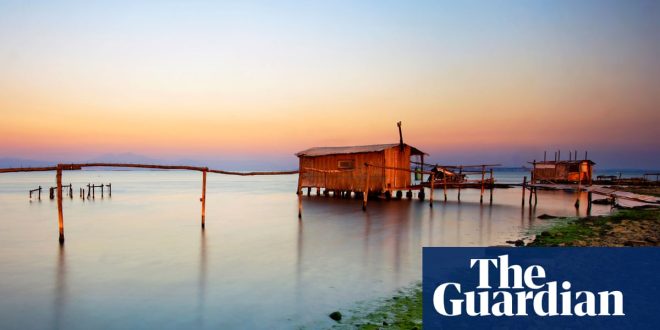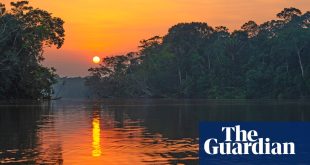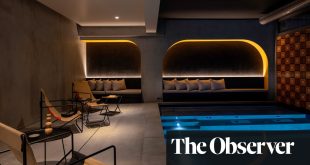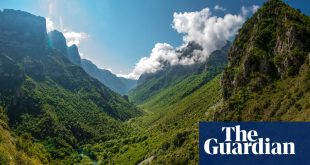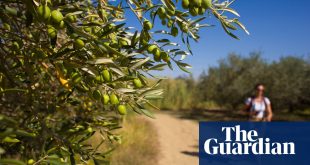Explore the Axios delta and stay in Thessaloniki
A neat line of wooden houses on stilts sits over water, with fishing boats tied up between them. Marshland stretches as far as the eye can see, blending with the sky. In a mirror-like lagoon, salmon-pink flamingos stalk the shallows, their beaks trawling for crustaceans.
This waterlogged world is the Axios delta, where the Axios River, flowing from the Albania-Kosovo border, meets Greece’s longest river, the Aliakmon, and the Loudias, to form a basin on the Thermaic Gulf just west of Thessaloniki. Now a national park, its mosaic of fresh waters, brackish lagoons, salt marshes, reed beds and mudflats is an important refuge for millions of migrating and nesting birds, including glossy ibis, dalmatian pelicans and rare white-tailed eagles. It’s a photographer’s dream and a wonderful place to explore on foot.
A car is still useful to get from point to point, though local buses from Thessaloniki run to Kalochori lagoon in the eastern section and the birdwatching tower in Nea Agathoupoli in the south. The best place to see flamingos is around the salt pans of Alyki Kitros in the south. A map and advice on the best routes depending on the time of year are available from the information centre in Chalastra. Local group ecoroutes.gr occasionally organises day tours, including a boat trip (€30pp).
Besides about 300 bird species, the delta is home to spotted turtles, tortoises, wildcats, sousliks (a type of squirrel), recently reintroduced water buffalo and wild horses. Dykes divide wide, flat paddy fields, while mussels are cultivated on ropes and gathered in by fishers. Most of the country’s rice and mussels are harvested here; and its salt pans produce one of the largest outputs in Greece after Messolonghi.
There’s basic accommodation on the delta outskirts, but it’s best to base yourself in Thessaloniki. Greece’s second-largest city has plenty of ancient sites, too. Bustling but laid-back, restaurant tables crowd its squares and nightlife lasts until morning.
A longer trip could take in mountainous Florina (a region and town) about two hours’ drive west from Thessaloniki: stay at the Lynx Mountain Resort (doubles from €135 B&B). Just outside the scenic mountain villages of Agrapidies and Nymfaio, Arcturos’s rescued bear, wolf and lynx sanctuaries give visitors the chance to see the animals up close on guided tours that run hourly.
Eat The delta’s previously rough-and-ready eateries are being replaced by fashionable tavernas serving local salt- and freshwater fish. Navagio has a veranda on the lagoon at Kalochori; Sourotiri in Chalastra serves a local take on paella.
Stay In central Thessaloniki, Noa Hotel offers urban cool (doubles from €110 room-only). The Zeus is Loose hostel has twin rooms from €74 room-only.
Wine tasting on the Pelion peninsula
In the south of the Pelion, a peninsula 100 miles or so north of Athens with panoramic views of lush wooded hills and the Aegean, the family-run Patisti vineyard started going organic in 1980 to improve the health of the vines and complexity of the grapes.
Now, with a range of organic and biodynamic wines made with local varieties roditis, limnio and xinomavro, as well as syrah, cabernet sauvignon and more, Patisti estate offers winery tours as well as olive oil tasting. Just outside the red-roofed village of Argalasti, it’s a delightful spot to taste the terroir, and the slopes covered in vines give the region the look of a little Tuscany.
Milea Winery, also in the village, is open to visitors too. Chardonnay, merlot and pinot noir are cultivated using a dry-farm technique, making the vines dig deep for water, building character and resilience. Milonas nearby focuses on quality, small volume production with its red, white and rosé available in the village, and plans to open to visitors in the future.
Beyond wine, the Pelion, with the Aegean on one side and the Pagasetic Gulf on the other, has lots to offer. From regional capital Volos, the coast road winds up into villages of slate-roofed stone houses and plane-tree-shaded squares. There’s a narrow-gauge train from Ano Lechonia to Milies, or hikers can follow the Pelion Routes, a network of paths developed by the local community. Among the best beach options are Mylopotamos, the mile-and-a-half long Horefto, Plaka and Potistika.
From Volos there are ferries to Skiathos and Skopelos. Continuing the wine theme, on Skiathos, Parissis Winery, on the island’s highest hill overlooking the harbour, uses entirely Greek varietals and is another example of a new generation of winemakers.
Eat Pelion is known for its produce, including olives and fruit, all available at Argalasti farmers’ market, which has tavernas around the square. Specialities include oregano-flavoured “meatballs” made of potato and feta, and sauteed wild greens with eggs.
Stay Within easy reach of Argalasti, Lafkos Guesthouse is traditional and charming (doubles from €70 a night), while Nikoleri Studios (doubles from €52) are right on the water at peaceful Lefokastro.
Karpathos, an authentic taste of island life
Whether you approach the north of Karpathos island on the vertigo-inducing narrow road that winds up the coast or by ferry to the tiny port of Diafani, there’s a sense of a big, dramatic landscape, with mountain peaks covered with wind-bent pines falling away to the deep blue. Amid these slopes, the village of Olympos comes as a surprise: tiers of colourful houses, crumbling windmills above and a green valley below.
This remote and long self-sufficient community has preserved its customs where many islands lost theirs. Traces of ancient language remain in the dialect, and older women wear traditional dresses, headscarves and leather boots, carrying heavy loads on sticks across their shoulders and baking bread in outdoor wood-fired ovens. Men play an ancient form of bagpipes and sing improvised rhymes.
In mid-summer, Olympos is a tourism honeypot with groups thronging the main alleyway – but a glimpse of authentic life is on offer from Evangelia of Ecotourism Karpathos, who is passionate about her heritage. In her cooking class, visitors learn how to make makarounes pasta with goat’s cheese in the kitchen of a house decorated with carved wooden furniture and embroideries.
She also guides walks to the chapel at the summit of the mountain above the village, where the winds that Karpathos is known for keep hikers cool enough to enjoy panoramic views to Rhodes, Halki and even Crete.
Since most tourists leave Olympos mid-afternoon, those who stay a few nights can enjoy the cool of the evening as clouds sweep over the peak of Profitis Ilias. The village is car-free so, in the morning, cockerels and sheep are the only sounds. For breakfast, Kalliope’s bakery serves hortopita (spinach pie) from its wood-fired oven built into the mountainside.
Boats run regularly along the coast from Diafani in the summer, and are worth a trip for views of the island from the water. Passengers can jump off at a wild beach for swimming and snorkelling. Excursions from here (and from the main town of Pigadia) include the abandoned island of Saria, for swimming and ancient ruins.
Karpathos is a large island of high mountains and pine trees, with several pretty resorts: heading south from Olympos on the east coast road are peaceful Ayios Nikolaos and lush Kyra Panagia, while further south beyond the town of Pigadia lie the shallow pale waters of Amoopi Bay. Beyond there, the windsurfing around Afiartis draws aficionados. Traditional island villages worth seeing include Mesochori, Othos and Menetes.
Eat On the tiny square next to the main church in Olympos, Parthenon, run by Nikos Filippakis, offers good food year-round and also functions as a locals’ bar. The most famous taverna is Mylos, with terraces around the old windmill, while Drosia, run by Evgenia and her mother, Sophia, serves goat from their own herd.
Stay Anemos Guesthouse in Olympos (from €76) has three suites whose windows and large balconies have views of the coastline and village houses clinging to the mountain.
Astypalea, a laid-back jewel of the Aegean
Astypalea is one of the Dodecanese islands, but has a strong flavour of the Cyclades to the west. Its relative isolation has helped it retain its wild side and authentic charm, with most of its 1,000 permanent inhabitants living in the village of Chora, the capital and a jewel of the Aegean, with white houses clustered around a conical hill rising from the sea, topped by the Venetian-built Querini Castle. The old town offers just the right blend of laid-back and sophisticated, with great bars and stylish boutiques. The local biscotti-like biscuits called paximadia with almonds or saffron are not to missed.
Chora gets lively in summer, but in Maltezana, five miles away, you wake to the sound of goat bells and, if you’re staying at Akrotiri Studios, the gentle lapping of the sea. Fishing cottages around a tiny church right on the bay have been restored into holiday houses with views across the sheltered bay.
after newsletter promotion
Maltezana, named for the Maltese pirates who once wrought havoc here, is one of Astypalea’s three main villages and has plenty of holiday accommodation, a handful of tavernas, cafes, a mini-market and a bakery; but still feels pleasantly rural, with low white buildings set amid trees and bamboo, and gentle hills. Ducks and peacocks strut along the waterfront; at night owls can be heard.
The popular swimming spot of Ble Limanaki is 10 minutes on foot from the centre of the village, and a strip of sand and shady trees fringes the bay. Captain Antonis operates boat trips to the islets nearby. Inland, past the windmill, is Agia Varvara, an early Christian basilica with intricate mosaic floors.
After the sun sets, Kafenes Maltezos, run by Panayiotis, has a welcoming atmosphere, good music and great food: tomato fritters, skordalia (garlic potato mash), big prawns pan-fried in a rich sauce with onions and peppers, and fresh chlori cheese with deliciously moist and springy bread. Drop in for a drink and you may still be dancing in the early hours.
North-east of Maltezana, the road heads up into the wild emptiness of Mesa Nisi, the eastern part of the island, which has secluded bays, an eerie military station from the second world war, and the inlet of Vathy, with a few ancient ruins and an old lime kiln that supported the community until the 1970s.
In the other direction, the road leading south-west passes the beaches of Stenó, where the island narrows to 100 metres across, before reaching Chora. South of Chora, Livadi has a wide stretch of sand and pebbles with accommodation unobtrusively set back behind a row of tavernas, and is a peaceful place to swim and eat with sand between your toes. From here, the road passes hotels and bays on the way to Exo Nisi – the rugged, empty western part of the butterfly-shaped island.
Eat Kafenes Maltezos is the place to head in Maltezana; in Pera Gialos, Chora’s harbour, Argo offers great local food with a view, and pretty Maistrali is open all day (lobster with spaghetti is the speciality).
Stay Akrotiri in Maltezana has sea-view studios from €50 a night. Kallichoron is a lovely boutique hotel in Chora (doubles from about €110 B&B, three-night minimum).
Hike the Menalon trail, Peloponnese
The 46-mile Menalon Trail winds through the centre of the Peloponnese, crossing forested mountain scenery dotted with hilltop villages and churches in a region rich in religious and revolutionary history. It has been named one of the best hiking paths in Europe by the European Ramblers Association, yet still attracts a fraction of the crowds of more famous routes.
The trail starts in Stemnitsa, with its stone tower-houses perched at more than 1,000 metres, and the eight stages range from 2½ to 8 ½ miles, finishing in Lagkadia. It’s possible to complete the route in four or five days – some people even run it – though a more leisurely approach is recommended. It can be walked independently using the official website and signage, or on a guided tour with operators such as Trekking Hellas or No Footprint.
The first 7½ miles to Dimitsana are tough yet rewarding, descending into the Lousios gorge. The monastery of Saint John the Baptist – probably built in the 16th century – clings to the canyon wall and served as a refuge, secret school and hospital during the Greek Revolution of 1821 against the Ottomans. Dimitsana is a beautiful and popular stop, with places to stay and tavernas.
From here, the trail ascends to Zygovisti, straddles the Menalon massif via springs and chapels to reach Elati, then descends to the Milaon River, with its abandoned watermills. Look out for swimming spots close to the village of Vytina.
Other route highlights include the Panagia Kernitsa monastery and the cave hermitage of Sphyrida; Magouliana, one of the highest villages in the Peloponnese; and the wood-carving village of Valtesiniko. The final nine miles leads to a ridge with ruins of a Byzantine fortress before meandering down to Lagkadia.
It’s best to avoid the height of summer when temperatures soar. Though some sections are well shaded, walk early in the morning or late in the afternoon, regularly topping up on water. The official website gives information on local temperatures and what you need for a safe hike. Taxis are easily available if needed – phone numbers are posted along the route.
Eat Many tavernas have been family run for generations and focus on local produce and traditional cuisine, such as wild boar stew with local pasta (hilopites). To Tsipouradiko tou Panteli in Nymfasia is worth a try, and Iosif in Maglouliana uses meat and cheese from its own farm.
Stay Spend the first night in Stemnitsa at Tsarbou Guesthouse (doubles from €75 room-only), rest weary bones at Anastasia’s Suites Arcadia in Vytina (doubles from €110), and celebrate the end of the trail at Gileri Eco and Design (from €102) in Lagdakia.
Cargo sailing eco-adventure
Imagine setting sail in a small boat across the Aegean with a cargo of island honeys, wines and cheeses, maybe stopping to pick up locally brewed beer and jars of rock samphire in Ikaria or acorn pasta in Kea.
Aegean Cargo Sailing allows guests to do just that by joining sailing boats that transport artisan products around the region. Having first begun reviving commercial sailing on millennia-old routes, the company then started inviting paying guests for a unique holiday as “crew”.
The boat has five double cabins and guests help with docking, loading and cleaning, as well as practising sailing skills and enjoying the sea, sunsets and stars. Powered almost entirely by the wind (the diesel engine is not used unless necessary), it is a low-impact way of exploring that helps local entrepreneurs too.
This August there’s a choice of four week-long itineraries on board Lafri as she sails the north Aegean, starting and ending in Andros, with Chios, Psara, Lesbos, Lemnos and Skiathos among the stops en route.
Produce transported may include sustainably fished tuna from Alonissos in the Sporades – the speciality of family business Alelma – or delicious cheese from Diaseli on Ios in the Cyclades. Guests have opportunities to visit producers, as well as to relax on deserted beaches, visit ancient sites or join in local festivals.
Lafri’s operator also has a smaller boat: Pelago, a solar electric-powered sailing boat with crewing opportunities from March to October, and basic accommodation that’s “more like camping sailing”.
Eat Breakfast with local island products is included, and for lunch and dinner, guests can cook on board or go to a restaurant on shore.
Stay Six nights on Lafri including accommodation in a double cabin, meals on board, visits to producers and tastings costs from €1,200; a second person sharing the cabin gets a 40% discount.
 Top Naija News – Nigeria News, Nigerian News & Top Stories Top Naija News – Nigerian Newspapers, Nigerian News. topnaijanews is a daily Nigerian newspaper covering Latest News, Breaking News, Entertainment, Sports, Lifestyle and Politics.
Top Naija News – Nigeria News, Nigerian News & Top Stories Top Naija News – Nigerian Newspapers, Nigerian News. topnaijanews is a daily Nigerian newspaper covering Latest News, Breaking News, Entertainment, Sports, Lifestyle and Politics.
